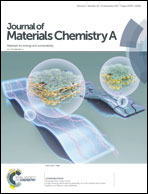Surfactant-free synthesis of a nanoperforated graphene/nitrogen-doped carbon nanotube composite for supercapacitors†
Abstract
A nanoperforated graphene/carbon nanotube (PG/CNT) composite is fabricated by electrostatic interaction of graphene oxide (GO) and nitrogen-doped CNTs, and subsequent catalytic carbon gasification. The nitrogen-doped sites (pyridinic N sites) of the CNTs are protonated under acidic conditions owing to the lone pair electrons, rendering the CNTs positively charged. The nitrogen-doped CNTs are uniformly incorporated into PG to form the PG/CNT composite through electrostatic attraction between the positively charged CNTs and the negatively charged GO. The resulting PG/nitrogen-doped CNT (N-CNT) composite exhibits outstanding electrochemical properties, showing high specific capacitance (288 F g−1 at 0.5 A g−1) and high rate capability (267 F g−1 at 20 A g−1) as well as excellent cycling stability (99% capacitance retention after 30 000 charge/discharge cycles). This is attributable to not only the formation of a high concentration of edge sites in PG and improvements of cross-plane ion diffusion owing to the nanoperforations, but also the enhancements in the ion-accessible area and in-plane ion diffusion due to the incorporation of N-CNT nanospacers into PG.



 Please wait while we load your content...
Please wait while we load your content...